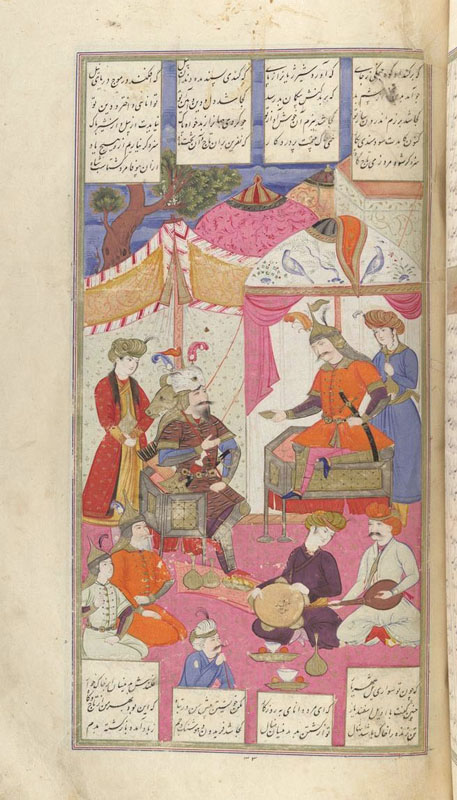Rostam Feasts with Esfandiyār
Prior to the actual combat between them, there was a meeting at Esfandiyār’s encampment, during which the two protagonists consumed a meal and exchanged verbal abuses. The event depicted in this painting appears to be that meeting, and not as Jackson and Yohannan suggest, one that took place after the battle. But as Melville has pointed out, the illustration comes a little late in the text of the manuscript, some 40 verses late at a point where Esfandiyār has already been killed by Rostam. Yet Esfandiyār is shown here very much alive. The setting is outdoors in the tent encampment of Esfandiyār. The prince, clad in a pointed helmet, knee length coat, and leather guards on his forearms and legs, sits on an elevated hexagonal throne under a tent pavilion in the upper right. The artist has experienced some difficulty rendering the foreshortening of his legs, with the result that the lower portion of his body appears awkward and deformed. Esfandiyār offers a drink to Rostam, who sits defiantly before him, on the left side of the composition. Rostam has his familiar attributes - leopard and tiger skin cuirass, and bull-headed mace. Standing behind each of the protagonists is a turbanned youth holding a flacon. In the lower right foreground two turbanned musicians are seated, one with a tambourine, the other with a lute. Seated opposite them, on the left, is an old man and a boy. The youth might be identified as Esfandiyār’s son Bahman, but he is depicted much younger than one might visualize from the text, where he was employed by Esfandiyār as an emissary to Rostam. In the extreme foreground is a turbanned man with a large mustache, leaning on a walking stick. His lower extremities are cropped by the text, a device often utilized by Mo¯in. Vessels containing fruit and drink are scattered about, and additional tents can be seen in the background. In the far background is a single tree and a patch of sky.
Painting: 25 x 16.5 cm. The text is written in four columns above and below the painting, with a rectangular frame enclosing all. There are numerous areas of abrasion or flaking, but no serious damage. The miniscule signature, raqam-e kamineh fażl ʿali, is inscribed on the sky at the top. On the face of the tambourine, written in Moʿin’s hand, is the signature raqam zad kamina moʿin-e moṣavver. Attributed by Jackson and Yohannan to Fażl ¯Ali, and by Robinson to Moʿin with the assistance of Fażl ʿAli. The painting is in excellent Mo¯in style except for the sky which could be the work of Fażl ʿAli.
Painting references:
J&Y_1914, p.37, no.34 (not ill.).
Robinson, Cochran4_1972, p.79, no.34.
Cambridge Shahnameh Project
Text references: Warner, V, p.200; Mohl, IV, p.492 ff; Levy, pp.202-3.
Robert Eng
Last Updated: February 21, 2011 | Originally published: June 18, 2003
